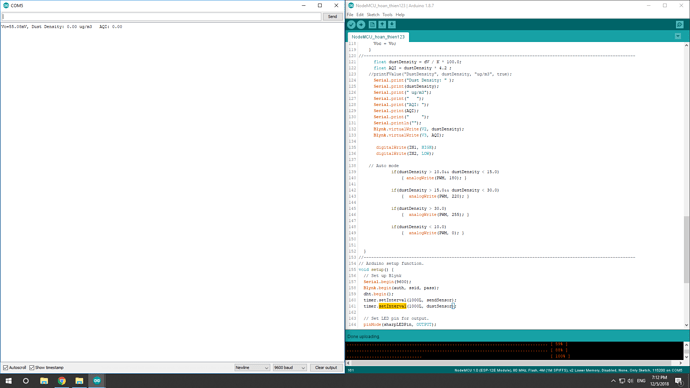Hello. I’m a beginner. I have problems. My code run perfectly with Arduino Uno - it read dust density data from the sensor then control the fan but when I adjust it for Nodemcu it works but the fan not stop spinning although the dust density is below the condition I set in if clause. Another problem is that Nodemcu doesn’t work if I disconnect USB cable from my computer by use 3.3V power - Sensors don’t run and no data transfer to blynk app and nodemcu doesn’t connect to wifi hostpost too :rowning:
My device includes:
- 12V 01.11A PWM Fan 4pin
- NodeMCU 1.0 V3
- L298 bridge
- DHT22
- Sharp dust sensor gp2y10
//Air Purifier
//------------------------------------------------------------------------------------------------------------
const int IN1 = D5; //L298 14= D5
const int IN2 = D6; //L298 13= D6
const int IN3 = D7; //L298 12= D7
const int IN4 = D8; //L298 15= D8
const int PWM = D2;
#define BLYNK_PRINT Serial
#include <ESP8266WiFi.h>
#include <BlynkSimpleEsp8266.h>
#include <SimpleTimer.h>
#include <DHT.h>
#include "DHT.h"
#include "SharpGP2Y10.h"
#include <SPI.h>
char auth[] = "50f3a727f0d0403db542d94694f15be2";
char ssid[] = "Air Purifier";
char pass[] = "minhtamqq";
#define DHTPIN D4
#define DHTTYPE DHT22
DHT dht(DHTPIN, DHTTYPE);
SimpleTimer timer;
void sendSensor() {
float h = dht.readHumidity(); //Doc gia tri do am
float t = dht.readTemperature(); //Doc gia tri nhiet do
float f = dht.readTemperature(true);
// Gan du lieu vao bien virtual de hien thi len blynk
// Chi nen gan 10 bien tro xuong
delay(10);
Blynk.virtualWrite(V0, h);
Blynk.virtualWrite(V1, t);
}
//------------------------------------------------------------------------------------------------------------
// Choose program options.
//#define PRINT_RAW_DATA
#define USE_AVG
// Arduino pin numbers.
const int sharpLEDPin = D2; // Arduino digital pin 7 connect to sensor LED.
const int sharpVoPin = A0; // Arduino analog pin 5 connect to sensor Vo.
// For averaging last N raw voltage readings.
#ifdef USE_AVG
#define N 100
static unsigned long VoRawTotal = 0;
static int VoRawCount = 0;
#endif // USE_AVG
// Set the typical output voltage in Volts when there is zero dust.
static float Voc = 0.6;
// Use the typical sensitivity in units of V per 100ug/m3.
const float K = 0.5;
//------------------------------------------------------------------------------------------------------------
// Helper functions to print a data value to the serial monitor.
void printValue(String text, unsigned int value, bool isLast = false) {
Serial.print(text);
Serial.print("=");
Serial.print(value);
if (!isLast) {
Serial.print(", ");
}
}
void printFValue(String text, float value, String units, bool isLast = false) {
Serial.print(text);
Serial.print("=");
Serial.print(value);
Serial.print(units);
if (!isLast) {
Serial.print(", ");
}
}
//------------------------------------------------------------------------------------------------------------
// Arduino setup function.
void setup() {
// Set up Blynk
Serial.begin(9600);
Blynk.begin(auth, ssid, pass);
dht.begin();
timer.setInterval(1000L, sendSensor);
// Set LED pin for output.
pinMode(sharpLEDPin, OUTPUT);
// Start the hardware serial port for the serial monitor.
Serial.begin(9600);
// Wait two seconds for startup.
delay(2000);
Serial.println("");
Serial.println("DUST SENSOR SHARP GP2Y1014AU0F");
Serial.println("");
//------------------------------------------------------------------------------------------------------------
//FAN
pinMode (IN1, OUTPUT );
pinMode (IN2, OUTPUT );
pinMode (IN3, OUTPUT );
pinMode (IN4, OUTPUT );
pinMode (PWM, OUTPUT );
}
//------------------------------------------------------------------------------------------------------------
// Arduino main loop.
void loop() {
//Blynk set up
Blynk.run();
timer.run();
// Turn on the dust sensor LED by setting digital pin LOW.
digitalWrite(sharpLEDPin, LOW);
// Wait 0.28ms before taking a reading of the output voltage as per spec.
delayMicroseconds(280);
// Record the output voltage. This operation takes around 100 microseconds.
int VoRaw = analogRead(sharpVoPin);
// Turn the dust sensor LED off by setting digital pin HIGH.
digitalWrite(sharpLEDPin, HIGH);
// Wait for remainder of the 10ms cycle = 10000 - 280 - 100 microseconds.
delayMicroseconds(9620);
// Print raw voltage value (number from 0 to 1023).
#ifdef PRINT_RAW_DATA
printValue("VoRaw", VoRaw, true);
Serial.println("");
#endif // PRINT_RAW_DATA
// Use averaging if needed.
float Vo = VoRaw;
#ifdef USE_AVG
VoRawTotal += VoRaw;
VoRawCount++;
if ( VoRawCount >= N ) {
Vo = 1.0 * VoRawTotal / N;
VoRawCount = 0;
VoRawTotal = 0;
} else {
return;
}
#endif // USE_AVG
// Compute the output voltage in Volts. NodeMCU 3.3V
Vo = Vo / 1024.0 * 3.3;
printFValue("Vo", Vo*1000.0, "mV");
// Convert to Dust Density in units of ug/m3.
float dV = Vo - Voc;
if ( dV < 0 ) {
dV = 0;
Voc = Vo;
}
//------------------------------------------------------------------------------------------------------------
float dustDensity = dV / K * 100.0;
float AQI = dustDensity * 4.2 ;
//printFValue("DustDensity", dustDensity, "ug/m3", true);
Serial.print("Dust Density: " );
Serial.print(dustDensity);
Serial.print(" ug/m3");
Serial.print(" ");
Serial.print("AQI: ");
Serial.print(AQI);
Serial.print(" ");
Serial.println("");
Blynk.virtualWrite(V2, dustDensity);
Blynk.virtualWrite(V3, AQI);
delay(100);
//------------------------------------------------------------------------------------------------------------
digitalWrite(IN1, HIGH);
digitalWrite(IN2, LOW);
// Auto mode
if((dustDensity) > (10)&&((dustDensity) < (15)))
{ analogWrite(PWM, 180); }
if((dustDensity) > (15.0)&&((dustDensity) < (30.0)))
{ analogWrite(PWM, 220); }
if((dustDensity) > (30.0))
{ analogWrite(PWM, 255); }
if((dustDensity) < 10.0)
{ analogWrite(PWM, 0); }
} // END PROGRAM


